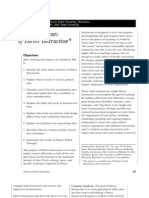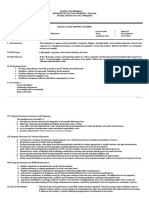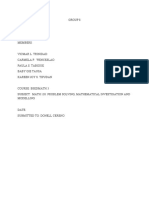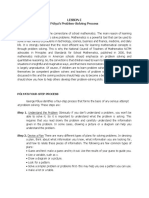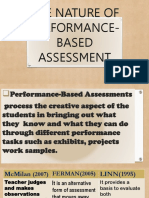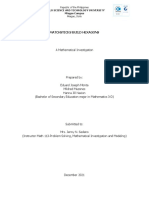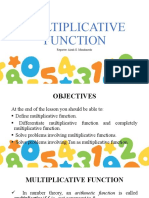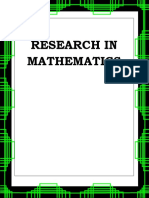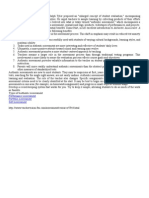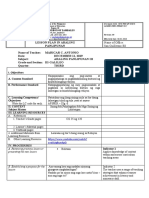Research in Math Midterm
Uploaded by
JEREMIAS DE LA CRUZResearch in Math Midterm
Uploaded by
JEREMIAS DE LA CRUZRESEARCH IN MATHEMATICS
LODILYN L. DOMETITA, LPT
OSMEÑA COLLEGES College of Teacher Education
Aspire…Achieve…Advance!
RESEARCH
MIDTERM
OVERVIEW
You have been an active participant in the process of education, initially as a student, and now as a teacher or
counsellor or as an educational administrator. While carrying out educational activities, you have to take decisions
about how to plan learning experiences, how to organize an institutional activity like examinations or admissions,
how to develop a distance education program or how to deliver a course through distance education. While taking
those decisions, you must have used your own experience and knowledge.
LEARNING OUTCOMES
Differentiate research process between conducting fundamental/basic research and action research
Identify research phenomena in the current teaching and learning practices in Mathematics
Generate possible research questions from the research phenomenon identified
Develop research questions.
Identify relevant and appropriate literature and studies on the research problem/s identified
Collect literature and studies relevant to the research problem/s identified
LEARNING EXPERIENCES & SELF-ASSESSMENT ACTIVITIES
(SAA)
ACTIVITY
Using the spider web below list down all the possible characteristics/ features you think an action research
has.
OSMEÑA COLLEGES College of Teacher Education
Aspire…Achieve…Advance!
ABSTRACTION
Fundamental Research
Fundamental research, also known as basic research or pure research does not usually generate findings
that have immediate applications in a practical level. Fundamental research is driven by curiosity and the
desire to expand knowledge in specific research area. This type of research makes a specific contribution to the
academic body of knowledge in the research area.
Fundamental studies tend to make generalizations about the phenomenon, and the philosophy of this type of
studies can be explained as ‘gathering knowledge for the sake of knowledge’. Fundamental researches mainly
aim to answer the questions of why, what or how and they tend to contribute the pool of fundamental
knowledge in the research area.
Opposite to fundamental research is applied research that aims to solve specific problems, thus findings of
applied research do have immediate practical implications.
Action research
Description
Action research is a philosophy and methodology of research generally applied in the social sciences. It seeks
transformative change through the simultaneous process of taking action and doing research, which are linked
together by critical reflection.
The Action Research Process
Educational action research can be engaged in by a single teacher, by a group of colleagues who share an interest in
a common problem, or by the entire faculty of a school. Whatever the scenario, action research always involves the
same seven-step process. These seven steps, which become an endless cycle for the inquiring teacher, are the
following:
1. Selecting a focus
2. Clarifying theories
3. Identifying research questions
4. Collecting data
5. Analyzing data
6. Reporting results
7. Taking informed action
Step 1—Selecting a Focus
The action research process begins with serious reflection directed toward identifying a topic or topics worthy of a
busy teacher's time. Considering the incredible demands on today's classroom teachers, no activity is worth doing
unless it promises to make the central part of a teacher's work more successful and satisfying. Thus, selecting a
focus, the first step in the process, is vitally important. Selecting a focus begins with the teacher researcher or the
team of action researchers asking:
OSMEÑA COLLEGES College of Teacher Education
Aspire…Achieve…Advance!
What element(s) of our practice or what aspect of student learning do we wish to investigate?
Step 2—Clarifying Theories
The second step involves identifying the values, beliefs, and theoretical perspectives the researchers hold relating to
their focus. For example, if teachers are concerned about increasing responsible classroom behavior, it will be
helpful for them to begin by clarifying which approach—using punishments and rewards, allowing students to
experience the natural consequences of their behaviors, or some other strategy—they feel will work best in helping
students acquire responsible classroom behavior habits.
Step 3—Identifying Research Questions
Once a focus area has been selected and the researcher's perspectives and beliefs about that focus have been
clarified, the next step is to generate a set of personally meaningful research questions to guide the inquiry.
Step 4—Collecting Data
Professional educators always want their instructional decisions to be based on the best possible data. Action
researchers can accomplish this by making sure that the data used to justify their actions are valid (meaning the
information represents what the researchers say it does) and reliable (meaning the researchers are confident about
the accuracy of their data). Lastly, before data are used to make teaching decisions, teachers must be confident that
the lessons drawn from the data align with any unique characteristics of their classroom or school.
To ensure reasonable validity and reliability, action researchers should avoid relying on any single source of data.
Most teacher researchers use a process called triangulation to enhance the validity and reliability of their findings.
Basically, triangulation means using multiple independent sources of data to answer one's questions. Triangulation is
like studying an object located inside a box by viewing it through various windows cut into the sides of the box.
Observing a phenomenon through multiple “windows” can help a single researcher compare and contrast what is
being seen through a variety of lenses.
When planning instruction, teachers want the techniques they choose to be appropriate for the unique qualities of
their students. All teachers have had the experience of implementing a “research-proven” strategy only to have it fail
with their students. The desire of teachers to use approaches that “fit” their particular students is not dissimilar to a
doctor's concern that the specific medicine being prescribed be the correct one for the individual patient. The ability
of the action research process to satisfy an educator's need for “fit” may be its most powerful attribute. Because the
data being collected come from the very students and teachers who are engaged with the treatment, the relevance of
the findings is assured.
For the harried and overworked teacher, “data collection” can appear to be the most intimidating aspect of the entire
seven-step action research process. The question I am repeatedly asked, “Where will I find the time and expertise to
develop valid and reliable instruments for data collection?”, gives voice to a realistic fear regarding time
management. Fortunately, classrooms and schools are, by their nature, data-rich environments. Each day a child is in
class, he or she is producing or not producing work, is interacting productively with classmates or experiencing
difficulties in social situations, and is completing assignments proficiently or poorly. Teachers not only see these
events transpiring before their eyes, they generally record these events in their grade books. The key to managing
triangulated data collection is, first, to be effective and efficient in collecting the material that is already swirling
OSMEÑA COLLEGES College of Teacher Education
Aspire…Achieve…Advance!
around the classroom, and, second, to identify other sources of data that might be effectively surfaced with tests,
classroom discussions, or questionnaires.
Step 5—Analyzing Data
Although data analysis often brings to mind the use of complex statistical calculations, this is rarely the case for the
action researcher. A number of relatively user-friendly procedures can help a practitioner identify the trends and
patterns in action research data. During this portion of the seven-step process, teacher researchers will methodically
sort, sift, rank, and examine their data to answer two generic questions:
What is the story told by these data?
Why did the story play itself out this way?
By answering these two questions, the teacher researcher can acquire a better understanding of
the phenomenon under investigation and as a result can end up producing grounded theory
regarding what might be done to improve the situation.
Step 6—Reporting Results
It is often said that teaching is a lonely endeavor. It is doubly sad that so many teachers are left alone in their
classrooms to reinvent the wheel on a daily basis. The loneliness of teaching is unfortunate not only because of its
inefficiency, but also because when dealing with complex problems the wisdom of several minds is inevitably better
than one.
The sad history of teacher isolation may explain why the very act of reporting on their action research has proven so
powerful for both the researchers and their colleagues. The reporting of action research most often occurs in
informal settings that are far less intimidating than the venues where scholarly research has traditionally been
shared. Faculty meetings, brown bag lunch seminars, and teacher conferences are among the most common venues
for sharing action research with peers. However, each year more and more teacher researchers are writing up their
work for publication or to help fulfill requirements in graduate programs. Regardless of which venue or technique
educators select for reporting on research, the simple knowledge that they are making a contribution to a collective
knowledge base regarding teaching and learning frequently proves to be among the most rewarding aspects of this
work.
Step 7—Taking Informed Action
Taking informed action, or “action planning,” the last step in the action research process, is very familiar to most
teachers. When teachers write lesson plans or develop academic programs, they are engaged in the action planning
process. What makes action planning particularly satisfying for the teacher researcher is that with each piece of data
uncovered (about teaching or student learning) the educator will feel greater confidence in the wisdom of the next
steps. Although all teaching can be classified as trial and error, action researchers find that the research process
liberates them from continuously repeating their past mistakes. More important, with each refinement of practice,
action researchers gain valid and reliable data on their developing virtuosity.
OSMEÑA COLLEGES College of Teacher Education
Aspire…Achieve…Advance!
Three Purposes for Action Research
As stated earlier, action research can be engaged in by an individual teacher, a collaborative group of colleagues
sharing a common concern, or an entire school faculty. These three different approaches to organizing for research
serve three compatible, yet distinct, purposes:
Building the reflective practitioner
Making progress on schoolwide priorities
Building professional cultures
Building the Reflective Practitioner
When individual teachers make a personal commitment to systematically collect data on their work, they are
embarking on a process that will foster continuous growth and development. When each lesson is looked on as an
empirical investigation into factors affecting teaching and learning and when reflections on the findings from each
day's work inform the next day's instruction, teachers can't help but develop greater mastery of the art and science of
teaching. In this way, the individual teachers conducting action research are making continuous progress in
developing their strengths as reflective practitioners.
Making Progress on Schoolwide Priorities
Increasingly, schools are focusing on strengthening themselves and their programs through the development of
common focuses and a strong sense of esprit de corps. Peters and Waterman (1982) in their landmark book, In
Search of Excellence, called the achievement of focus “sticking to the knitting.” When a faculty shares a
commitment to achieving excellence with a specific focus—for example, the development of higher-order thinking,
positive social behavior, or higher standardized test scores—then collaboratively studying their practice will not
only contribute to the achievement of the shared goal but would have a powerful impact on team building and
program development. Focusing the combined time, energy, and creativity of a group of committed professionals on
a single pedagogical issue will inevitably lead to program improvements, as well as to the school becoming a “center
of excellence.” As a result, when a faculty chooses to focus on one issue and all the teachers elect to enthusiastically
participate in action research on that issue, significant progress on the schoolwide priorities cannot help but occur.
Building Professional Cultures
Often an entire faculty will share a commitment to student development, yet the group finds itself unable to adopt a
single common focus for action research. This should not be viewed as indicative of a problem. Just as the medical
practitioners working at a “quality” medical center will hold a shared vision of a healthy adult, it is common for all
the faculty members at a school to share a similar perspective on what constitutes a well-educated student. However,
like the doctors at the medical center, the teachers in a “quality” school may well differ on which specific aspects of
the shared vision they are most motivated to pursue at any point in time.
Schools whose faculties cannot agree on a single research focus can still use action research as a tool to help
transform themselves into a learning organization. They accomplish this in the same manner as do the physicians at
the medical center. It is common practice in a quality medical center for physicians to engage in independent, even
OSMEÑA COLLEGES College of Teacher Education
Aspire…Achieve…Advance!
idiosyncratic, research agendas. However, it is also common for medical researchers to share the findings obtained
from their research with colleagues (even those engaged in other specialties).
School faculties who wish to transform themselves into “communities of learners” often empower teams of
colleagues who share a passion about one aspect of teaching and learning to conduct investigations into that area of
interest and then share what they've learned with the rest of the school community. This strategy allows an entire
faculty to develop and practice the discipline that Peter Senge (1990) labeled “team learning.” In these schools,
multiple action research inquiries occur simultaneously, and no one is held captive to another's priority, yet everyone
knows that all the work ultimately will be shared and will consequently contribute to organizational learning.
Research phenomenon
Phenomenon-driven research is problem-oriented research that focuses on capturing,
documenting, and conceptualizing organizational and managerial phenomena of interest
in order to facilitate knowledge creation and advancement’ (Schwarz & Stensaker, 2015).
A research phenomenon can be any problem, issue, or topic that is chosen as the subject
of an investigation. The phenomenon may originate in either the practical world of
affairs, a theoretical discipline, or a personal experience or insight. It may be perceived to
represent an unsatisfying circumstance, a promising opportunity, a breakdown or
anomaly in expected arrangements, or simply a topic of interest.
Developing research questions
It is likely that at some point during your degree you will be required to create your own research
question. The research question states the specific issue or problem that your assignment will
focus on. It also outlines the task that you will need to complete.
There is no universal set of criteria for a good research question. Different disciplines have
different priorities and requirements. A good research question for a history paper will differ
from a good research question for a biology paper. In general, however, a good research question
should be:
Clear and focused. In other words, the question should clearly state what the writer
needs to do.
Not too broad and not too narrow. The question should have an appropriate scope. If
the question is too broad it will not be possible to answer it thoroughly within the word
limit. If it is too narrow you will not have enough to write about and you will struggle to
develop a strong argument (see the activity below for examples).
Not too easy to answer. For example, the question should require more than a simple yes
or no answer.
Not too difficult to answer. You must be able to answer the question thoroughly within
the given timeframe and word limit.
Researchable. You must have access to a suitable amount of quality research materials,
such as academic books and refereed journal articles.
OSMEÑA COLLEGES College of Teacher Education
Aspire…Achieve…Advance!
Analytical rather than descriptive. In other words, your research question should allow
you to produce an analysis of an issue or problem rather than a simple description of it
How to create a research question
1. Determine the requirements
Before you can construct a good research question you will need to determine the requirements
of your assignment.
What is the purpose of this assignment? Is it to test a proposition? Is it to evaluate a set of data?
Is it to state and defend an argument? Check the assignment instructions and discuss the purpose
with your tutor or lecturer.
Determining the purpose will help you to choose the most appropriate topic and word your
question in the most useful way.
2. Choose a topic
Have you been given a list of topics to choose from or can you choose your own? Check the
assignment instructions and if you are still in doubt discuss the requirements with your tutor or
lecturer.
The best approach is to choose a topic that you are interested in. If you are interested in your
topic you are more likely to invest more time, effort, and creativity into your research and
writing. The greater your interest, the more likely it is that you will produce an assignment that is
interesting to read.
3. Conduct preliminary research
Before you write your question it is advisable to read a small number of relevant academic
sources. Limit your reading to recently published material and perhaps one or two influential
works on the topic. The goal here is to familiarize yourself with the key debates in academic
writing on the topic.
Reading in order to develop a research question is different from reading in order to answer it.
Focus on the main ideas and arguments (these are usually found in the introduction and the
conclusion). You don’t need to read every word or take down extensive notes at this stage, as
you will probably come back to the text at a later date.
4. Narrow down your topic
Having conducted some preliminary research you should now be in a position to narrow down
your topic.
In most cases you will need to narrow down your focus to a specific issue or debate within the
broader topic. This is because it is much more effective to cover a single issue or dimension of a
topic in depth than to skim the surface of several.
OSMEÑA COLLEGES College of Teacher Education
Aspire…Achieve…Advance!
There are several ways that you might go about narrowing down your topic:
Think about the subtopics, specific issues, and key debates that exist within the broader
topic.
Think about the value of focusing on a particular period of time, a particular geographical
location, a particular organization, or a particular group of people.
Think about what you want to say in your assignment. What are the key points and
arguments that you want to get across? Which subtopic, timeframe or other limitation
would allow you to make these points in the most effective way?
5. Write your question
Now that you have narrowed down your topic you can turn your attention to the wording of your
research question.
As mentioned previously, the research question must outline a clear task that you will need to
complete.
Remember that you will need to keep the purpose of your assignment in mind when thinking
about the wording of your question and that the purpose will differ from discipline to discipline
(see 1: Determine the Requirements).
In general, however, a good research question requires you to analyse an issue or
problem. How and why questions are therefore more useful than what or describe questions.
Other useful words that you might use are critique, argue, examine and evaluate.
LITERATURE REVIEW
How to write a literature review
A literature review is a survey of scholarly sources on a specific topic. It provides an overview of
current knowledge, allowing you to identify relevant theories, methods, and gaps in the existing
research.
Writing a literature review involves finding relevant publications (such as books and journal
articles), critically analyzing them, and explaining what you found. There are five key steps:
1. Search for relevant literature
2. Evaluate sources
3. Identify themes, debates and gaps
4. Outline the structure
5. Write your literature review
A good literature review doesn’t just summarize sources – it analyzes, synthesizes, and critically
evaluates to give a clear picture of the state of knowledge on the subject.
OSMEÑA COLLEGES College of Teacher Education
Aspire…Achieve…Advance!
Why write a literature review?
When you write a thesis, dissertation, or research paper, you will have to conduct a literature
review to situate your research within existing knowledge. The literature review gives you a
chance to:
Demonstrate your familiarity with the topic and scholarly context
Develop a theoretical framework and methodology for your research
Position yourself in relation to other researchers and theorists
Show how your research addresses a gap or contributes to a debate
You might also have to write a literature review as a stand-alone assignment. In this case, the
purpose is to evaluate the current state of research and demonstrate your knowledge of scholarly
debates around a topic.
The content will look slightly different in each case, but the process of conducting a literature
review follows the same steps.
Step 1: Search for relevant literature
Before you begin searching for literature, you need a clearly defined topic.
If you are writing the literature review section of a dissertation or research paper, you will search
for literature related to your research problem and questions.
If you are writing a literature review as a stand-alone assignment, you will have to choose a
focus and develop a central question to direct your search. Unlike a dissertation research
question, this question has to be answerable without collecting original data. You should be able
to answer it based only on a review of existing publications.
Research question example. What is the impact of social media on body image among Generation Z?
Make a list of keywords
Start by creating a list of keywords related to your research question. Include each of the key
concepts or variables you’re interested in, and list any synonyms and related terms. You can add
to this list if you discover new keywords in the process of your literature search.
Keywords example
Social media, Facebook, Instagram, Twitter, Snapchat, TikTok
Body image, self-perception, self-esteem, mental health
Generation Z, teenagers, adolescents, youth
Search for relevant sources
Use your keywords to begin searching for sources. Some useful databases to search for journals
and articles include:
Your university’s library catalogue
Google Scholar
OSMEÑA COLLEGES College of Teacher Education
Aspire…Achieve…Advance!
JSTOR
EBSCO
Project Muse (humanities and social sciences)
Medline (life sciences and biomedicine)
EconLit (economics)
Inspec (physics, engineering and computer science)
You can use boolean operators to help narrow down your search:
AND to find sources that contain more than one keyword (e.g. social media AND body image
AND generation Z)
OR to find sources that contain one of a range of synonyms (e.g. generation Z OR teenagers OR
adolescents)
NOT to exclude results containing certain terms (e.g. apple NOT fruit)
Step 2: Evaluate and select sources
You probably won’t be able to read absolutely everything that has been written on the topic –
you’ll have to evaluate which sources are most relevant to your questions.
For each publication, ask yourself:
What question or problem is the author addressing?
What are the key concepts and how are they defined?
What are the key theories, models and methods? Does the research use established frameworks or
take an innovative approach?
What are the results and conclusions of the study?
How does the publication relate to other literature in the field? Does it confirm, add to, or
challenge established knowledge?
How does the publication contribute to your understanding of the topic? What are its key insights
and arguments?
What are the strengths and weaknesses of the research?
Make sure the sources you use are credible, and make sure you read any landmark studies and
major theories in your field of research.
You can find out how many times an article has been cited on Google Scholar – a high citation
count means the article has been influential in the field, and should certainly be included in your
literature review.
The scope of your review will depend on your topic and discipline: in the sciences you usually
only review recent literature, but in the humanities you might take a long historical perspective
(for example, to trace how a concept has changed in meaning over time).
Take notes and cite your sources
As you read, you should also begin the writing process. Take notes that you can later incorporate
into the text of your literature review.
It is important to keep track of your sources with citations to avoid plagiarism. It can be helpful
to make an annotated bibliography, where you compile full citation information and write a
OSMEÑA COLLEGES College of Teacher Education
Aspire…Achieve…Advance!
paragraph of summary and analysis for each source. This helps you remember what you read and
saves time later in the process.
You can use our free citation generator to quickly create correct and consistent APA
citations or MLA citations. Want to check your literature review for plagiarism? Try
Scribbr’s Plagiarism Checker for students.
Step 3: Identify themes, debates, and gaps
To begin organizing your literature review’s argument and structure, you need to understand the
connections and relationships between the sources you’ve read. Based on your reading and notes,
you can look for:
Trends and patterns (in theory, method or results): do certain approaches become more or
less popular over time?
Themes: what questions or concepts recur across the literature?
Debates, conflicts and contradictions: where do sources disagree?
Pivotal publications: are there any influential theories or studies that changed the direction of
the field?
Gaps: what is missing from the literature? Are there weaknesses that need to be addressed?
This step will help you work out the structure of your literature review and (if applicable) show
how your own research will contribute to existing knowledge.
Example of trends and gapsIn reviewing the literature on social media and body image, you note that:
Most research has focused on young women.
There is an increasing interest in the visual aspects of social media.
But there is still a lack of robust research on highly visual platforms like Instagram and Snapchat
– this is a gap that you could address in your own research.
Step 4: Outline your literature review’s structure
There are various approaches to organizing the body of a literature review. You should have a
rough idea of your strategy before you start writing.
Depending on the length of your literature review, you can combine several of these strategies
(for example, your overall structure might be thematic, but each theme is discussed
chronologically).
Chronological
The simplest approach is to trace the development of the topic over time. However, if you choose
this strategy, be careful to avoid simply listing and summarizing sources in order.
Try to analyze patterns, turning points and key debates that have shaped the direction of the field.
Give your interpretation of how and why certain developments occurred.
OSMEÑA COLLEGES College of Teacher Education
Aspire…Achieve…Advance!
Thematic
If you have found some recurring central themes, you can organize your literature review into
subsections that address different aspects of the topic.
For example, if you are reviewing literature about inequalities in migrant health outcomes, key
themes might include healthcare policy, language barriers, cultural attitudes, legal status, and
economic access.
Methodological
If you draw your sources from different disciplines or fields that use a variety of research
methods, you might want to compare the results and conclusions that emerge from different
approaches. For example:
Look at what results have emerged in qualitative versus quantitative research
Discuss how the topic has been approached by empirical versus theoretical scholarship
Divide the literature into sociological, historical, and cultural sources
Theoretical
A literature review is often the foundation for a theoretical framework. You can use it to discuss
various theories, models, and definitions of key concepts.
You might argue for the relevance of a specific theoretical approach, or combine various
theoretical concepts to create a framework for your research.
Step 5: Write your literature review
Like any other academic text, your literature review should have an introduction, a main body,
and a conclusion. What you include in each depends on the objective of your literature review.
Introduction
The introduction should clearly establish the focus and purpose of the literature review.
Dissertation literature review.
If you are writing the literature review as part of your dissertation or thesis, reiterate your central problem
or research question and give a brief summary of the scholarly context. You can emphasize the timeliness
of the topic (“many recent studies have focused on the problem of x”) or highlight a gap in the literature
(“while there has been much research on x, few researchers have taken y into consideration”).
Stand-alone literature review. \
If you are writing a stand-alone paper, give some background on the topic and its importance, discuss the
scope of the literature you will review (for example, the time period of your sources), and state your
objective. What new insight will you draw from the literature?
Body
Depending on the length of your literature review, you might want to divide the body into
subsections. You can use a subheading for each theme, time period, or methodological approach.
OSMEÑA COLLEGES College of Teacher Education
Aspire…Achieve…Advance!
As you write, you can follow these tips:
Summarize and synthesize: give an overview of the main points of each source and combine
them into a coherent whole
Analyze and interpret: don’t just paraphrase other researchers—add your own interpretations
where possible, discussing the significance of findings in relation to the literature as a whole
Critically evaluate: mention the strengths and weaknesses of your sources
Write in well-structured paragraphs: use transition words and topic sentences to draw
connections, comparisons and contrasts
Example of a paragraph in a literature review
Body image issues have been widely associated with social media usage, particularly in young
women. The relation between media depictions and body image concerns is well-established; a meta-
analysis by Grabe, Ward and Hyde (2008) concluded that exposure to mass media is linked to body image
dissatisfaction among women. However, in an era of rapidly changing digital technologies, the mass
media paradigm is no longer adequate for understanding how people engage with images, and the
findings of older studies like this one may not be generalizable to younger generations. In light of this
changing landscape, researchers have become increasingly interested in the specific effects of social
media. Perloff (2014) theorizes that the interactive aspects of social media may influence its impact on
body image, and mentions that young women are among the most active social media users. Several
empirical studies have focused on Facebook usage in adolescent girls (Tiggermann & Slater, 2013; Meier
& Gray, 2014) and in young adult women (Smith, Hames, & Joiner, 2013; Fardouly et al., 2015; Cohen,
Newton-John & Slater, 2017), while a systematic review by Holland and Timmerman (2016) confirmed a
relationship between social networking and body image for both women and men. Across these studies,
there is consistent evidence that body image issues are influenced not by social media usage in general,
but by engagement with the visual and interactive aspects of these platforms. Nonetheless, there is a lack
of robust research on more highly visual social media (HVSM) such as Instagram and Snapchat that have
gained more recent popularity among younger generations.
Conclusion
In the conclusion, you should summarize the key findings you have taken from the literature and
emphasize their significance.
Dissertation literature review
If the literature review is part of your thesis or dissertation, show how your research addresses gaps and
contributes new knowledge, or discuss how you have drawn on existing theories and methods to build a
framework for your research.
Stand-alone literature review
If you are writing a stand-alone paper, you can discuss the overall implications of the literature or make
suggestions for future research based on the gaps you have identified.
There are several reasons to conduct a literature review at the beginning of a research project:
To familiarize yourself with the current state of knowledge on your topic
To ensure that you’re not just repeating what others have already done
To identify gaps in knowledge and unresolved problems that your research can address
To develop your theoretical framework and methodology
To provide an overview of the key findings and debates on the topic
OSMEÑA COLLEGES College of Teacher Education
Aspire…Achieve…Advance!
Writing the literature review shows your reader how your work relates to existing research and
what new insights it will contribute.
APPLICATION
Do these:
- Identify research phenomena about the current teaching of
Mathematics subject in the school considering the situation under the
covid-19 pandemic. ( List down five phenomena)
- Choose three phenomena among the five phenomena you’ve listed
and develop 5 questions about it.
OSMEÑA COLLEGES College of Teacher Education
Aspire…Achieve…Advance!
LOOKING AHEAD
Congratulations for making it till the end of this module! If you aced the assessments, I am happy for you. If you have not
reached your desired level of competence, just keep going! Remember that an expert was once a beginner.
Now that you have finished the review of the various concepts outlined above, it is now time for an assessment to see how
far you have improved. On every module’s “End of Module Assessment” (this part), write your answers on separate
END OF
sheet/s provided. (See MODULE ASSESSMENT
separate sheets for the questions.)
This part requires you to rate
SELF AND MODULE
the quality of the module to
EVALUATION
help continuously improve
the development of this
learning module. This also
asks you to rate your
learning experience for each
of the modules.
The learning module: 1 2 3 4
Rate the module
using the following:
4 - Strongly disagree
Please check appropriate column
3 - Disagree
was engaging
2 - Agree
allowed for self-checking (SAAs)
1 - Strongly agree
developed in gradual, manageable steps
provided independent, self-paced learning
contained relevant information I needed
REFERENCES
https://www.questionpro.com/blog/research-design/#:~:text=The%20design%20of
%20a%20research,collection%2C%20measurement%2C%20and%20analysis.
http://egyankosh.ac.in/bitstream/123456789/41933/1/Unit-1.pdf
OSMEÑA COLLEGES College of Teacher Education
Aspire…Achieve…Advance!
END OF MODULE ASSESSMENT ANSWER SHEET
(Please do not forget to provide information on this part)
Name: _____________________________________________ Course& Year:_____________
Module Number and Title: ______________________________________________________
Contact number & email (if any):_______________________________
Date accomplished: ________________________
Do the following:
- Think of a research problem about teaching
Mathematics subject in this time of pandemic.
(20 points)
- Write a descriptive essay about your chosen research
problem. (30 points)
- Go online and find literature reviews that is related on
your research problem. (List down at least 5 literature
reviews). (50 points)
OSMEÑA COLLEGES College of Teacher Education
Aspire…Achieve…Advance!
You might also like
- Module 1 in Assessment and Evaluation in MathematicsNo ratings yetModule 1 in Assessment and Evaluation in Mathematics28 pages
- Academic Predictors of The Licensure Examination For Teachers' Performance of The Rizal Technological University Teacher Education GraduatesNo ratings yetAcademic Predictors of The Licensure Examination For Teachers' Performance of The Rizal Technological University Teacher Education Graduates10 pages
- March: Technology in Teaching and Learning 2No ratings yetMarch: Technology in Teaching and Learning 29 pages
- Assessment and Evaluation in Mathematics SyllabusNo ratings yetAssessment and Evaluation in Mathematics Syllabus15 pages
- Performance Standards, Competencies, and Learning Targets in MathematicsNo ratings yetPerformance Standards, Competencies, and Learning Targets in Mathematics39 pages
- Problem Based Instructional Plan DevelopmentNo ratings yetProblem Based Instructional Plan Development17 pages
- Factors Affecting Problem Solving Skills Among The Students of College of Teacher EducationsNo ratings yetFactors Affecting Problem Solving Skills Among The Students of College of Teacher Educations2 pages
- Lesson 4 Principles and Strategies in Teaching MathematicsNo ratings yetLesson 4 Principles and Strategies in Teaching Mathematics7 pages
- Mathematics in The Modern World: Module 4No ratings yetMathematics in The Modern World: Module 46 pages
- MM116 - Problem Solving, Mathematical Investigation and ModelingNo ratings yetMM116 - Problem Solving, Mathematical Investigation and Modeling7 pages
- Module I CONCEPTUAL FRAMEWORK OF MATHEMATICS EDUCATION COMPRA SUTCHEZA DAMAYO BSED3 ANo ratings yetModule I CONCEPTUAL FRAMEWORK OF MATHEMATICS EDUCATION COMPRA SUTCHEZA DAMAYO BSED3 A43 pages
- The Nature of Performance-Based AssessmentNo ratings yetThe Nature of Performance-Based Assessment17 pages
- Principles and Stategies in Teaching MathNo ratings yetPrinciples and Stategies in Teaching Math35 pages
- MATH 113 MI - Mrs. Jenny Sedano - Matchsticks Builds HexagonNo ratings yetMATH 113 MI - Mrs. Jenny Sedano - Matchsticks Builds Hexagon16 pages
- Chapter 1-Introduction To Non-Parametric StatisticsNo ratings yetChapter 1-Introduction To Non-Parametric Statistics10 pages
- Multiplicative Function: Reporter: Airah G. MondonedoNo ratings yetMultiplicative Function: Reporter: Airah G. Mondonedo17 pages
- Vc's Powerpoint - Spec 20 Instrumentation and Technology in MathematicsNo ratings yetVc's Powerpoint - Spec 20 Instrumentation and Technology in Mathematics30 pages
- Syllabus Calculus 1 With Analytic GeometryNo ratings yetSyllabus Calculus 1 With Analytic Geometry4 pages
- Learning Objective:: Marygracelyn - Nagas@deped - Gov.phNo ratings yetLearning Objective:: Marygracelyn - Nagas@deped - Gov.ph8 pages
- Topic 1: Process-Oriented Assessment: Learning ObjectivesNo ratings yetTopic 1: Process-Oriented Assessment: Learning Objectives2 pages
- Lesson 2 Principles and Strategies in Teaching MathematicsNo ratings yetLesson 2 Principles and Strategies in Teaching Mathematics5 pages
- Arithmetic-Sequence - JHS Teaching DemonstrationNo ratings yetArithmetic-Sequence - JHS Teaching Demonstration50 pages
- Module 2 - Assessment and Evaluation in MathematicsNo ratings yetModule 2 - Assessment and Evaluation in Mathematics18 pages
- Articulating K To 12 Competencies in Mathematics Learning With Success IndicatorsNo ratings yetArticulating K To 12 Competencies in Mathematics Learning With Success Indicators16 pages
- TEST I. (1 Point Each) Multiple Choice: Choose The Best Answer of The Following Item. Write The Letter of Your100% (1)TEST I. (1 Point Each) Multiple Choice: Choose The Best Answer of The Following Item. Write The Letter of Your3 pages
- Student Experiences Online Classesqual Study PDFNo ratings yetStudent Experiences Online Classesqual Study PDF10 pages
- Chapter 1 Description and History of Statistical ScienceNo ratings yetChapter 1 Description and History of Statistical Science2 pages
- Shades of Meaning Refers To The Small, Subtle Differences in Meaning Between Similar Words or Phrases.No ratings yetShades of Meaning Refers To The Small, Subtle Differences in Meaning Between Similar Words or Phrases.4 pages
- English-for-Teaching: Rethinking Teacher Proficiency in The ClassroomNo ratings yetEnglish-for-Teaching: Rethinking Teacher Proficiency in The Classroom11 pages
- A Written Report On:: Cpe 104: Facilitating Learner-Centered TeachingNo ratings yetA Written Report On:: Cpe 104: Facilitating Learner-Centered Teaching6 pages
- Guided TP - Individual Study Guidelines (Revised)No ratings yetGuided TP - Individual Study Guidelines (Revised)10 pages
- Sample Information Literacy Curriculum FrameworkNo ratings yetSample Information Literacy Curriculum Framework16 pages
- GES Lesson Plan Notes Basic 5 Week 5 Term1No ratings yetGES Lesson Plan Notes Basic 5 Week 5 Term117 pages
- School of Teacher Education: J.H. Cerilles State CollegeNo ratings yetSchool of Teacher Education: J.H. Cerilles State College3 pages
- Science ACCOMPLISHMENT-REPORT 2023 Updates100% (10)Science ACCOMPLISHMENT-REPORT 2023 Updates2 pages
- Research Methodologies Research ExerciseNo ratings yetResearch Methodologies Research Exercise14 pages
- ICT Integrated Lesson Class 2 English - Kinga - Namgay (DEA Pce06140035)No ratings yetICT Integrated Lesson Class 2 English - Kinga - Namgay (DEA Pce06140035)6 pages
- Module 1 in Assessment and Evaluation in MathematicsModule 1 in Assessment and Evaluation in Mathematics
- Academic Predictors of The Licensure Examination For Teachers' Performance of The Rizal Technological University Teacher Education GraduatesAcademic Predictors of The Licensure Examination For Teachers' Performance of The Rizal Technological University Teacher Education Graduates
- Performance Standards, Competencies, and Learning Targets in MathematicsPerformance Standards, Competencies, and Learning Targets in Mathematics
- Factors Affecting Problem Solving Skills Among The Students of College of Teacher EducationsFactors Affecting Problem Solving Skills Among The Students of College of Teacher Educations
- Lesson 4 Principles and Strategies in Teaching MathematicsLesson 4 Principles and Strategies in Teaching Mathematics
- MM116 - Problem Solving, Mathematical Investigation and ModelingMM116 - Problem Solving, Mathematical Investigation and Modeling
- Module I CONCEPTUAL FRAMEWORK OF MATHEMATICS EDUCATION COMPRA SUTCHEZA DAMAYO BSED3 AModule I CONCEPTUAL FRAMEWORK OF MATHEMATICS EDUCATION COMPRA SUTCHEZA DAMAYO BSED3 A
- MATH 113 MI - Mrs. Jenny Sedano - Matchsticks Builds HexagonMATH 113 MI - Mrs. Jenny Sedano - Matchsticks Builds Hexagon
- Chapter 1-Introduction To Non-Parametric StatisticsChapter 1-Introduction To Non-Parametric Statistics
- Multiplicative Function: Reporter: Airah G. MondonedoMultiplicative Function: Reporter: Airah G. Mondonedo
- Vc's Powerpoint - Spec 20 Instrumentation and Technology in MathematicsVc's Powerpoint - Spec 20 Instrumentation and Technology in Mathematics
- Learning Objective:: Marygracelyn - Nagas@deped - Gov.phLearning Objective:: Marygracelyn - Nagas@deped - Gov.ph
- Topic 1: Process-Oriented Assessment: Learning ObjectivesTopic 1: Process-Oriented Assessment: Learning Objectives
- Lesson 2 Principles and Strategies in Teaching MathematicsLesson 2 Principles and Strategies in Teaching Mathematics
- Module 2 - Assessment and Evaluation in MathematicsModule 2 - Assessment and Evaluation in Mathematics
- Articulating K To 12 Competencies in Mathematics Learning With Success IndicatorsArticulating K To 12 Competencies in Mathematics Learning With Success Indicators
- TEST I. (1 Point Each) Multiple Choice: Choose The Best Answer of The Following Item. Write The Letter of YourTEST I. (1 Point Each) Multiple Choice: Choose The Best Answer of The Following Item. Write The Letter of Your
- Chapter 1 Description and History of Statistical ScienceChapter 1 Description and History of Statistical Science
- Shades of Meaning Refers To The Small, Subtle Differences in Meaning Between Similar Words or Phrases.Shades of Meaning Refers To The Small, Subtle Differences in Meaning Between Similar Words or Phrases.
- English-for-Teaching: Rethinking Teacher Proficiency in The ClassroomEnglish-for-Teaching: Rethinking Teacher Proficiency in The Classroom
- A Written Report On:: Cpe 104: Facilitating Learner-Centered TeachingA Written Report On:: Cpe 104: Facilitating Learner-Centered Teaching
- School of Teacher Education: J.H. Cerilles State CollegeSchool of Teacher Education: J.H. Cerilles State College
- ICT Integrated Lesson Class 2 English - Kinga - Namgay (DEA Pce06140035)ICT Integrated Lesson Class 2 English - Kinga - Namgay (DEA Pce06140035)




